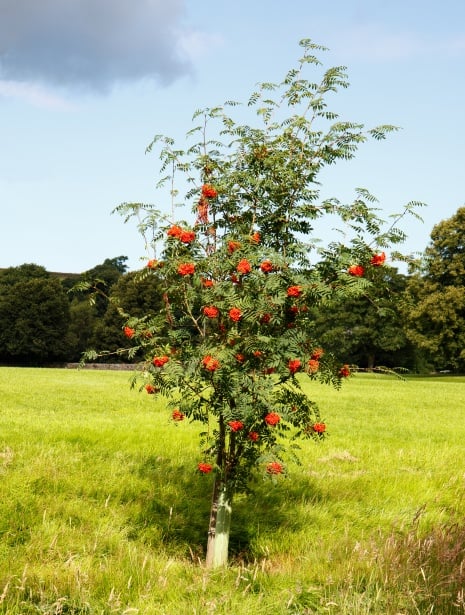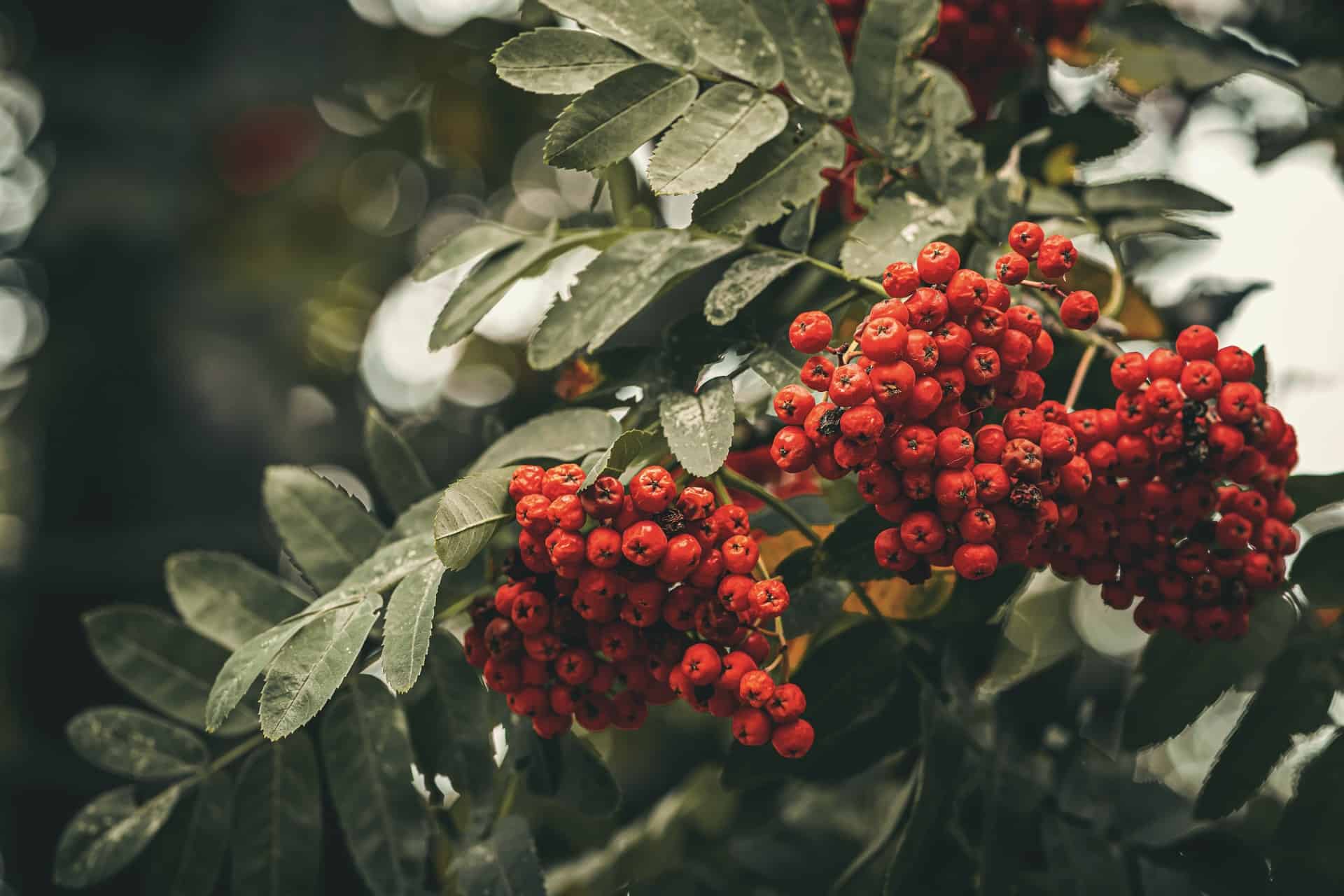
The common rowan tree (Sorbus aucuparia), sometimes known as a mountain ash in the UK is one of many deciduous trees (sometimes also found as a shrub). It has silvery, smooth bark, pinnate (feathery) foliage and dense clusters of blossoms, which develop into scarlet, berry-like fruit. This tree tends to be found naturally on upland areas on neutral and acid soils and also in lowland situations. The tree can be stunted in upland areas only growing to 5m but in lowland situations the common rowan can reach heights of 15m.
The common rowan looks like many other trees you might find on a walk – but this unassuming arbor has a long, fascinating history with its roots in ancient mythology and folklore – and a wealth of interesting facts…
A Rose by Any Other Name
Rowan trees or shrubs are actually in the genus Sorbus of the rose family, Rosaceae – but being a tree, they tend to be much taller – the European species can reach 15m – and tend to be taller than their American cousins – and they have been known to live for 200 years, however, their lifespan in our modern towns will be considerably shorter than this.
A Well-Travelled Tree
Native to the cooler Northern Hemisphere, rowans can be found in many places – but most variety of apomictic species of rowan can be discovered in the Himalya, Southern Tibet and areas of West China. The UKs native rowan (Sorbus acuparia) has a natural range of Europe to Turkey, the Caucasus and down to the coast of North Africa.

How to Spot a Rowan Tree
Mature trees can live for up to 200 years and can grow to 15m. The bark is smooth with silvery grey tones whereas leaf buds are purple and hairy. Leaves are often likened to feathers with 5-8 pairs of distinctive leaflets and one ‘terminal’ leaflet at the end. Each leaflet is long, oval and toothed.
The rowan tree is hermaphrodite, which means that every flower contains both male and female reproductive parts. Each flower bears five white petals and develop into scarlet fruits after pollination by insects.
Be careful not to confuse a rowan tree with ash (Fraxinus excelsior) or elder (Sambucus nigra). With this said, the leaflets on rowan trees are more serrated and almost pointed in comparison.
In the winter, the young twigs start hairy and later become smooth, whereas buds are hairy all over. Terminal buds (on the ends of shoots) are up to 8mm in length and lateral buds (in leaf axils) are found with 2-5 scales.

With Edible Berries (but Beware!)
Rowan berries should never be eaten raw (these contain high levels of parasorbic acid, which means they have diuretic and laxative properties and can cause an upset stomach!)
The rowan berry was once one of the wide variety of fruits consumed throughout North America and Europe – and can still be used to make rowan jelly – and even rowan wine.
It’s difficult to say exactly why rowan berries are no longer eaten as regularly – but it may have something to do with risk: unless you are an expert, rowan berries can look a lot like other, poisonous berries found on trees – so unless you are certain the fruit is edible – it’s probably best to avoid eating them.
A Tree with Many Uses…
The hardiness of rowan wood makes it perfect for furniture, construction and for making walking sticks. In Ancient Rome, it was also used to make utensils in dairy production, as the wood was believed to prevent curdling. The bark has also historically been used by Druids to dye ceremonial wool robes red or brown.
…and Many Names
Historically known in Scotland as the Gaelic names Luis, or caorunn (pronounced choroon, the ‘ch’ as in loch) – the rowan has been variously also known as the kerin, curin, mountain ash and the witch wiggin tree.
Baby Rowans
In Ireland and England the name Rowan emerged as a traditionally masculine name for babies (although more recently it has been used as a unisex name too) This Irish-Gaelic name is derived from the term Ruadhán, meaning “red-haired” – possibly due to the red-orange colour of the tree’s berries. Rowan is also a feminine name of Arabic origin, meaning “river in paradise”.
The Tree of Life
If you ever see a “tree of life symbol” (usually found on jewellery) – then you are looking at a depiction of a rowan tree. Sacred to Celtic culture (and also worn as a clan badge by the McLachlans and Malcolms), the rowan symbolises the fragile, yet determined nature of life.
The Flying Rowan
Rowan trees can be found in the unlikeliest of places – even at high altitudes where no other tree can survive. Ancient Celts believed the veil between heaven and the mortal realm was thinnest here – or in other words, closer to heaven.
Similarly, Scandinavians traditionally believed the higher rowan trees grew, the more magical it was (dubbing it “the flying rowan”) and commonly used its wood to make runes, small tablets inscribed with symbols and used in magic.
A Veil Between Worlds
In Wales, rowans were traditionally planted in cemeteries – and to cut one down was forbidden. In Scotland and Ireland, the names of loved ones were also commonly engraved in the bark of rowans to commemorate them.
Witchcraft and the Rowan
The stalks of rowan berries were seen by Pagans as similar to the pentacle, an ancient symbol of protection from harm – although the tree was also adopted as a protective talisman against potential enchantment by witch-fearing folk.
The First Woman
According to Ancient Norse Mythology, the first man ever to walk the earth was created from an ash tree – but the first woman was made from a rowan, who saved the life of the god Thor, from a fast flowing river deep in the Underworld.
The “Eagle Tree”
In Ancient Greek mythology, Hebe (goddess of youth) supplied a revitalising drink known as ambrosia to the gods from a magical goblet – but when she lost the goblet to demons, the gods sent forth an eagle to bring it back. In the brawl between the demons and the eagle, feathers and drops of blood were shed and fell to earth – hence the rowan’s red berries and feathery leaves.
Oh, Rowan Tree!
Last but not least – few trees could lay claim to having their very own song – but the rowan can: in a famous Scottish folk song, where a man looks back at his life and remembers the people he has loved and lost:
“On thy fair stem were mony names
Which now nae mair I see
But they’re engraven on my heart,
Forget they ne’er can be…”
Trees aren’t just part of the landscape – they’re a part of history, too – so taking care of them is important. Keep the story going & help your local trees to thrive.
If you need help with trees, contact your local tree consultant, today.
